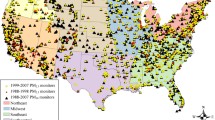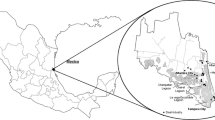Abstract
A source attribution study was performed to assess the contributions of specific pollutant source types to the observed particulate matter (PM) levels in the greater Cairo Area using the chemical mass balance (CMB) receptor model. Three intensive ambient monitoring studies were carried out during the period of February 21–March 3, 1999, October 27–November 27, 1999, and June 8–June 26, 2002. PM10, PM2.5, and polycyclic aromatic hydrocarbons (PAHs) were measured on a 24-h basis at six sampling stations during each of the intensive periods. The six intensive measurement sites represented background levels, mobile source impacts, industrial impacts, and residential exposure. Major contributors to PM10 included geological material, mobile source emissions, and open burning. PM2.5 tended to be dominated by mobile source emissions, open burning, and secondary species. This paper presents the results of the PM10 and PM2.5, source contribution estimates.
Similar content being viewed by others
References
Chow, J. C., & Watson, J. G. (1999). Cross border transport and spatial variability in Mexicali and California’s Imperial Valley. Atmospheric Environment, 34, 1833–1843.
Chow, J. C., Watson, J. G., Pritchett, L., Pierson, W., Frazier, C., & Purcell, R. (1993). The DRI thermal/optical carbon analysis system: Description, evaluation and applications in U.S. air quality studies. Atmospheric Environment, 27A, 1185–1202.
Fujita, E., Watson, J. G., Chow, J. C., Robinson, N. F., Richards, L. W., & Kumar, N. (1998). Northern front range air quality study volume C: Source apportionment and simulation methods and evaluation. Final Report Prepared for Colorado State University.
Gertler, A. W., Lowenthal, D. H., Howes, J. E., Jr., Sagebiel, J. C., Labib, M., Abu-Allaban, M., et al. (1999, June). Cairo source attribution study. (Paper presented at the AWMA 92nd National Meeting, St. Louis).
Kuykendal, W. B. (1990). Air Emissions Special Manual. Volume II: Particulate Matter Species Profiles, U.S. Environmental Protection Agency (EPA), Research Triangle Park, N.C., EPA-450/2-90-0001b.
Nasralla, M. M. (1994, October). Air pollution in greater Cairo. (Proceeding of the Italian–Egyptian study-days on the environment).
Pace, T. G. & Watson, J. G. (1987). Protocol for Applying and Validating the CMB Model. EPA 450/4-87-010, U.S. Environmental Protection Agency, Research Triangle Park, NC.
Rodes, C. E., Nasralla, M. M., & Lawless, P.A. (1996). An assessment and source apportionment of airborne particulate matter in Cairo, Egypt. Activity report no. 22, prepared for the USAID Mission to Egypt under EHP activity no. 133-RCm delivery order no. 7.
Sturchio, N., Sultan, M., Sharkaway, M. E., Maghraby, A. E., & Taher, A. (1997). Concentration and isotopic composition of lead in urban particulate air, Cairo, Egypt, 1966. Argonne National laboratory, Argonne, IL, and Center for Environmental Hazard Mitigation, Cairo University, Cairo, Egypt.
Watson, J. G., & Chow, J. C. (1993). Ambient air sampling. In K. Willeke, & P. Baron (Eds.), Aerosol measurement: Principles, techniques and applications. New York: Van Nostrand Reinhold, pp. 622–639.
Watson, J. G., Chow, J. C., Lu, Z., Fujita, E. M., Lowenthal, D. H., Lawson, D. R., et al. (1994). Chemical mass balance source apportionment of PM10 during the Southern California Air Quality Study. Aerosol Science and Technology, 21, 1–36.
Watson, J. G., Cooper, J. A., & Huntzicker, J. J. (1984). The effective variance weighting for least squares calculations applied to the mass balance receptor model. Atmospheric Environment, 18, 1347–1355.
Watson, J. G., Robinson, N. F., Chow, J. C., Henry, R. C., Kim, B. M., Pace, T. G., et al. (1990). The USEPA/DRI chemical mass balance receptor model, CMB 7.0. Environmental Software, 5, 38–49.
Author information
Authors and Affiliations
Corresponding author
Rights and permissions
About this article
Cite this article
Abu-Allaban, M., Lowenthal, D.H., Gertler, A.W. et al. Sources of PM10 and PM2.5 in Cairo’s ambient air. Environ Monit Assess 133, 417–425 (2007). https://doi.org/10.1007/s10661-006-9596-8
Received:
Accepted:
Published:
Issue Date:
DOI: https://doi.org/10.1007/s10661-006-9596-8




